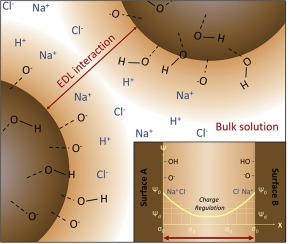Advances in Colloid and Interface Science ( IF 15.9 ) Pub Date : 2021-06-23 , DOI: 10.1016/j.cis.2021.102469 T Gil-Díaz 1 , D Jara-Heredia 2 , F Heberling 3 , J Lützenkirchen 3 , J Link 4 , T Sowoidnich 5 , H-M Ludwig 5 , M Haist 4 , T Schäfer 2

|
Surface chemistry of mineral phases in aqueous environments generates the electrostatic forces involved in particle-particle interactions. However, few models directly take into account the influence of surface speciation and changes in solution speciation when the diffuse layer potential profiles of approaching particles overlap and affect each other. These electrostatic interactions can be quantified, ideally, through charge regulation, considering solution and surface speciation changes upon particle approach by coupling state-of-the-art surface complexation models for the two particle surfaces with a Poisson-Boltzmann type distribution of electrostatic potential and ions in the inter-particle space. These models greatly improve the accuracy of inter-particle force calculations at small inter-particle separations compared to constant charge and constant potential approaches. This work aims at advancing charge regulation calculations by including full chemical speciation and advanced surface complexation models (Basic Stern-, three-, or four plane models and charge distribution concepts), for cases of similar and dissimilar surfaces involving the numerical solution of the Poisson-Boltzmann equation for arbitrary electrolytes. The concept was implemented as a Python-based code and in COMSOL. The flexibility and precision of both, concept and implementations are demonstrated in several benchmark calculations testing the new codes against published results or simulations using established speciation codes, including aqueous speciation, surface complexation and various interaction force examples. Due to the flexibility in terms of aqueous chemistry and surface complexation models for various geometries, a large variety of potential applications can be tackled with the developed codes including industrial, biological, and environmental systems, from colloidal suspensions to gas bubbles, emulsions, slurries like cement paste, as well as new possibilities to assess the chemistry in nano-confined systems.
中文翻译:

在纳米尺度上相互作用的电荷调节固液界面:广义物种形成代码 (SINFONIA) 的基准测试
水环境中矿物相的表面化学会产生涉及粒子-粒子相互作用的静电力。然而,当接近粒子的扩散层电位分布重叠并相互影响时,很少有模型直接考虑表面形态和溶液形态变化的影响。理想情况下,可以通过电荷调节来量化这些静电相互作用,通过将两个粒子表面的最先进的表面复合模型与静电势的泊松-玻尔兹曼型分布和粒子间空间中的离子。与恒定电荷和恒定电位方法相比,这些模型大大提高了在小颗粒间分离时颗粒间力计算的准确性。这项工作旨在通过包括完整的化学形态和高级表面络合模型(基本 Stern、三或四平面模型和电荷分布概念)来推进电荷调节计算,用于涉及泊松数值解的相似和不同表面的情况- 任意电解质的玻尔兹曼方程。这个概念是作为基于 Python 的代码在 COMSOL 中实现的。概念和实施的灵活性和精确性在几个基准计算中得到了证明,这些计算根据已发布的结果或使用既定的物种形成代码(包括水性物种形成)进行的模拟测试新代码,表面络合和各种相互作用力的例子。由于在水性化学和各种几何形状的表面络合模型方面具有灵活性,因此可以使用开发的代码处理大量潜在应用,包括工业、生物和环境系统,从胶体悬浮液到气泡、乳液、浆液,如水泥浆,以及评估纳米限制系统中化学的新可能性。











































 京公网安备 11010802027423号
京公网安备 11010802027423号